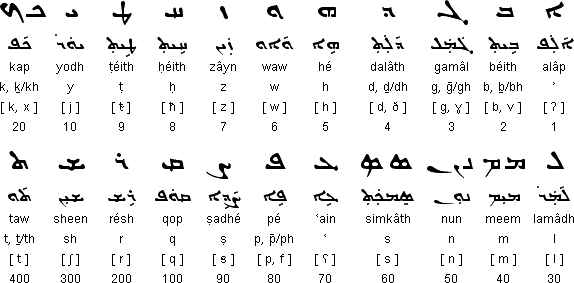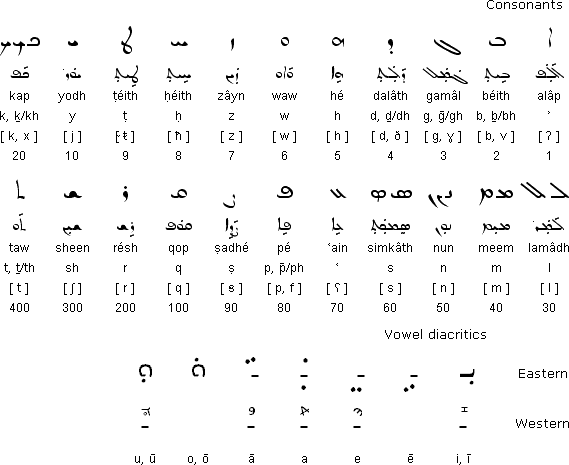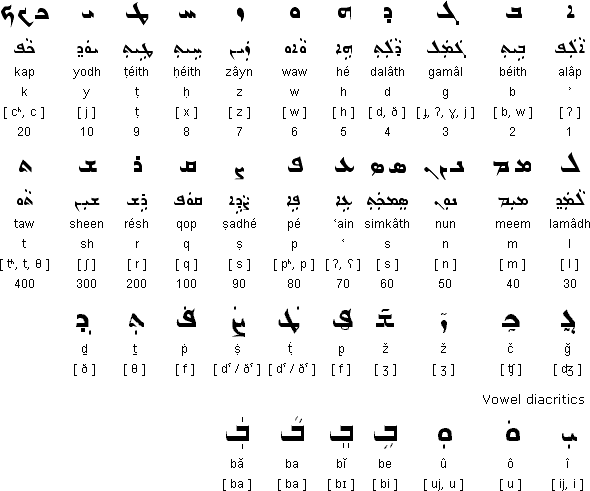![]()
The Syriac alphabet developed from the Aramaic alphabet and was used mainly to write the Syriac language from about the 2nd century BC. There are a number of different forms of the Syriac alphabet: Esṭrangelā (ܐܣܛܪܢܓܠܐ), Serṭā (ܣܪܛܐ) and Madnḥāyā (ܡܕܢܚܝܐ).
Esṭrangelā, meaning 'rounded', is the oldest form and is considered the classical version of the Syriac alphabet. It was revived during the 10th century, and is now used mainly in scholarly publications, titles and inscriptions.
West Syriac is generally written with Serṭā, meaning 'line', which is also known as the Pšīṭā (ܦܫܝܛܐ, 'simple'), Maronite or Jacobite. It was modelled on Esṭrangelā but with simpler, more flowing lines. A version of Serṭā appeared in the earliest Syriac manuscripts, and it became popular during the 8th century.
East Syriac is usually written in the Madnḥāyā (ܡܕܢܚܝܐ, 'Eastern') form of the alphabet, which is also known as Swādāyā (ܣܘܕܝܐ, 'conversational/contemporary'), Assyrian, Chaldean and Nestorian. Madnḥāyā is closer to Esṭrangelā than Serṭā.
Aramaic, a Semitic language that was the lingua franca of much of the Near East from about 7th century BC until the 7th century AD, when it was largely replaced by Arabic. Classical or Imperial Aramaic was the main language of the Persian, Babylonian and Assyrian empires and spread as far as Greece and the Indus valley.
After Alexander the Great destroyed the Persian Empire, Aramaic ceased to be the official language of any major state, though continued to be spoken widely. It was during this period that Aramaic split into western and eastern dialects.
Aramaic was once the main language of the Jews and appears in some of the Dead Sea Scrolls. It is still used as a liturgical language by Christian communities in Syria, Lebanon and Iraq, and is still spoken by small numbers of people in Iraq, Turkey, Iran, Armenia, Georgia and Syria.
Aramaic has also been written in versions of the Latin, Hebrew and Cyrillic alphabets, though the Syriac is the most widely used script to write Aramaic.
Syriac (ܠܫܢܐ ܣܘܪܝܝܐ leššānā Suryāyā), an eastern dialect of Aramaic spoken by Christians in the lands in between the Roman and Parthian empires between the 1st and 12th centuries. Syriac is still used used nowadays as ritual and literary language by speakers of Neo-Aramaic in Syria. It is also used for sermons in Syrian churches in the southern Indian state of Kerala. Syriac has also been written with the Uyghur alphabet.
Assyrian Neo-Aramaic, a member of the Aramaic branch of the Semitic language family spoken in parts of Iran, Iraq, Turkey and Syria by abour 220,000 people.



The letters kap and nun have three different forms, the one on the right is used in initial and medial positions, the one in the middle is used in final positions when connected to a previous letter, and the one of the left is used in final positions when unconnected to a previous letter. In Estrangelo the letter kap only has a different shape when in initial position.
The letters meem and simkâth have one form for initial and medial positions (right) and one form for final positions (left).
In the Serto script the letter lamâdh has a different initial form.
The vowel diacritics for î, ô and û are always attached to the letters y and w, while other vowels diacritics can be attached to any consonants.

Glory to Him who has glorified and exalted the Syriac language in His holy mouth, and [who] entrusted and handed over His life-giving teachings to His blessed apostles in Syriac; and the renowned forefathers and the skilled teachers of His Church have constituted and composed her beautiful liturgies in Aramaic, and explained and translated the living words of His salvation-bringing Gospel in the same [language].
Translated into English by Dirk Bakker
Information about Syriac | Tower of Babel

All human beings are born free and equal in dignity and rights. They are endowed with reason and conscience and should act towards one another in a spirit of brotherhood.
(Article 1 of the Universal Declaration of Human Rights)
Information about the Aramaic language and the Syraic alphabet
http://en.wikipedia.org/wiki/Syriac_alphabet
http://www.aramaicnt.org/
Learn Assyrian (Syriac-Aramaic) online
http://www.learnassyrian.com/aramaic/
Assyrian dictionary
https://assyrianlanguages.org/sureth/
Free Syriac fonts
http://www.wazu.jp/gallery/Fonts_Syriac.html
http://assyrianschool.weebly.com/free-fonts.html
http://www.bethmardutho.org/meltho/
Online Syriac radio and news
http://www.radiomalankara.com
http://www.radiobethgazo.com
Beth Mardutho: The Syriac Institute - promoting the study of Syriac heritage
http://www.bethmardutho.org
Peshitta Syriac New Testament complete with a Syriac primer
http://www.peshitta.org/
http://www.aifoundations.org/peshitta/peshitta_frames.html
Akkadian, Amharic, Arabic (Algerian), Arabic (Bedawi), Arabic (Chadian), Arabic (Egyptian), Arabic (Gulf), Arabic (Hassaniya), Arabic (Hejazi), Arabic (Lebanese), Arabic (Modern Standard), Arabic (Moroccan), Arabic (Najdi), Arabic (Sudanese), Arabic (Syrian), Aramaic, Argobba, Assyrian / Neo-Assyrian, Canaanite, Chaha, Chaldean Neo-Aramaic, Ge'ez, Hadhramautic, Harari, Hebrew, Himyaritic, Jewish Neo-Aramaic, Maltese, Mandaic, Nabataean, Neo-Mandaic, Phoenician, Punic, Qatabanic, Sabaean, Sabaic, Silt'e, Syriac, Tigre, Tigrinya, Turoyo, Ugaritic, Western Neo-Aramaic
Aramaic, Assyrian / Neo-Assyrian, Chaldean Neo-Aramaic, Neo-Mandaic, Suriyani Malayalam, Turoyo, Western Neo-Aramaic
Ancient Berber, Arabic, Aramaic, Chorasmian, Elymaic, Hatran, Hebrew, Manichaean, Nabataean, North Arabian, Pahlavi, Palmyrene, Parthian, Phoenician, Paleo-Hebrew, Proto-Sinaitic / Proto-Canaanite, Psalter, Punic, Sabaean, Samaritan, Sogdian, South Arabian, Syriac, Tifinagh, Ugaritic
Page last modified: 10.07.24
[top]
You can support this site by Buying Me A Coffee, and if you like what you see on this page, you can use the buttons below to share it with people you know.

If you like this site and find it useful, you can support it by making a donation via PayPal or Patreon, or by contributing in other ways. Omniglot is how I make my living.
Note: all links on this site to Amazon.com, Amazon.co.uk
and Amazon.fr
are affiliate links. This means I earn a commission if you click on any of them and buy something. So by clicking on these links you can help to support this site.
[top]